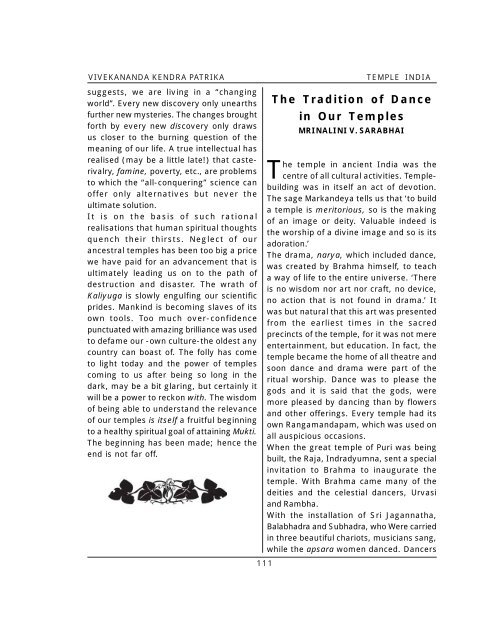Temples In India-1.pdf - Vivekananda Kendra Prakashan
Temples In India-1.pdf - Vivekananda Kendra Prakashan
Temples In India-1.pdf - Vivekananda Kendra Prakashan
You also want an ePaper? Increase the reach of your titles
YUMPU automatically turns print PDFs into web optimized ePapers that Google loves.
VIVEKANANDA KENDRA PATRIKAsuggests, we are living in a “changingworld”. Every new discovery only unearthsfurther new mysteries. The changes broughtforth by every new discovery only drawsus closer to the burning question of themeaning of our life. A true intellectual hasrealised (may be a little late!) that casterivalry,famine, poverty, etc., are problemsto which the “all-conquering” science canoffer only alternatives but never theultimate solution.It is on the basis of such rationalrealisations that human spiritual thoughtsquench their thirsts. Neglect of ourancestral temples has been too big a pricewe have paid for an advancement that isultimately leading us on to the path ofdestruction and disaster. The wrath ofKaliyuga is slowly engulfing our scientificprides. Mankind is becoming slaves of itsown tools. Too much over-confidencepunctuated with amazing brilliance was usedto defame our -own culture-the oldest anycountry can boast of. The folly has cometo light today and the power of templescoming to us after being so long in thedark, may be a bit glaring, but certainly itwill be a power to reckon with. The wisdomof being able to understand the relevanceof our temples is itself a fruitful beginningto a healthy spiritual goal of attaining Mukti.The beginning has been made; hence theend is not far off.111TEMPLE INDIAThe Tradition of Dancein Our <strong>Temples</strong>MRINALINI V. SARABHAIThe temple in ancient <strong>In</strong>dia was thecentre of all cultural activities. Templebuildingwas in itself an act of devotion.The sage Markandeya tells us that ‘to builda temple is meritorious, so is the makingof an image or deity. Valuable indeed isthe worship of a divine image and so is itsadoration.’The drama, narya, which included dance,was created by Brahma himself, to teacha way of life to the entire universe. ‘Thereis no wisdom nor art nor craft, no device,no action that is not found in drama.’ Itwas but natural that this art was presentedfrom the earliest times in the sacredprecincts of the temple, for it was not mereentertainment, but education. <strong>In</strong> fact, thetemple became the home of all theatre andsoon dance and drama were part of theritual worship. Dance was to please thegods and it is said that the gods, weremore pleased by dancing than by flowersand other offerings. Every temple had itsown Rangamandapam, which was used onall auspicious occasions.When the great temple of Puri was beingbuilt, the Raja, <strong>In</strong>dradyumna, sent a specialinvitation to Brahma to inaugurate thetemple. With Brahma came many of thedeities and the celestial dancers, Urvasiand Rambha.With the installation of Sri Jagannatha,Balabhadra and Subhadra, who Were carriedin three beautiful chariots, musicians sang,while the apsara women danced. Dancers
















